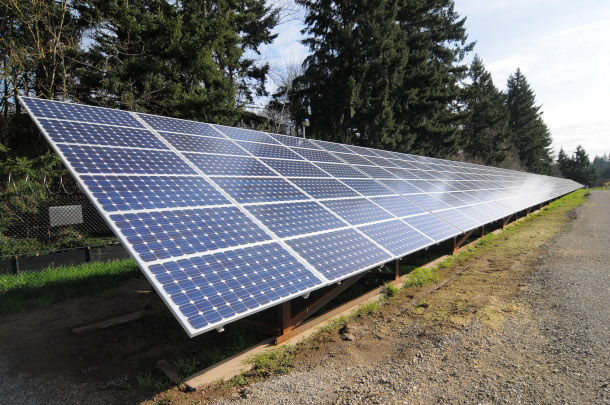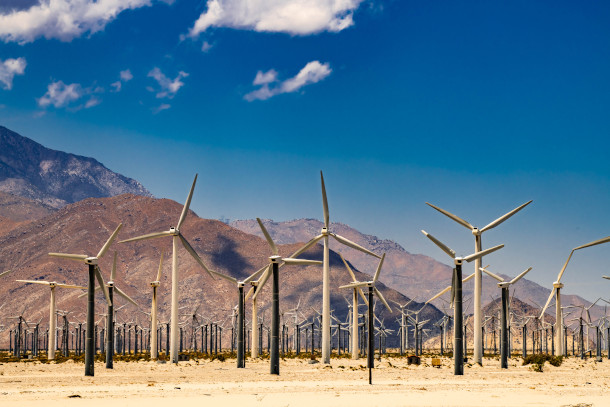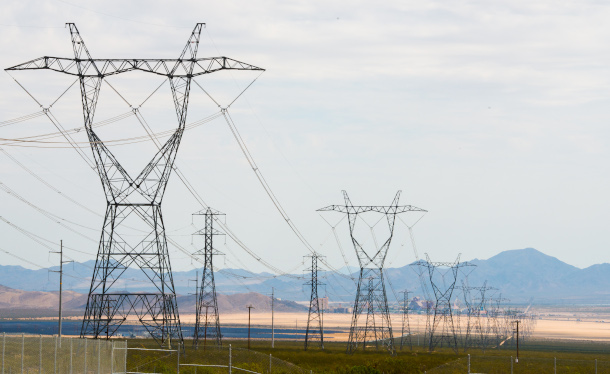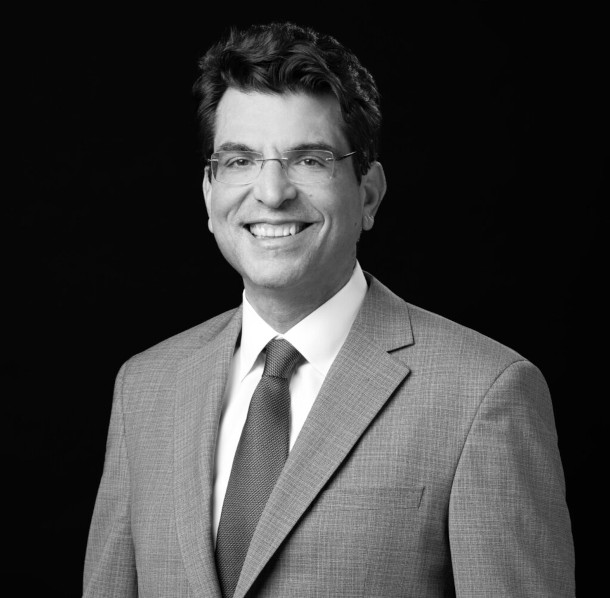Green Energy Gridlock
Air Date: Week of April 7, 2023

Among the states that have taken a variety of actions to encourage solar energy is Oregon. A 2017 state law bars homeowners’ associations from banning solar panels. (Photo by Portland General Electric, Flickr, CC BY-ND 2.0)
America can’t meet its goals of reducing carbon pollution from power plants unless power grids get major upgrades and rules to bring clean energy online are detangled. American Clean Power Association CEO Jason Grumet joins Host Jenni Doering to explain the challenges and opportunities facing implementation of the Inflation Reduction Act.
Transcript
CURWOOD: From PRX and the Jennifer and Ted Stanley Studios at the University of Massachusetts Boston, this is Living on Earth. I’m Steve Curwood.
DOERING: And I’m Jenni Doering.
To stand a chance of meeting President Biden’s goal of 100 percent carbon pollution-free electricity by 2035, the United States is going to have to level up the power grid from fossil fuel based energy sources to take advantage of clean, renewable power. And there are hundreds of billions of federal dollars to support those clean energy projects, thanks to the Inflation Reduction Act. But plugging in that power is proving difficult. In addition to the usual land use permits and approvals required for new projects, solar and wind farms also have to get permission from local grid operators, who are working through a huge backlog of competing projects to consider. And the system of power grids in the U.S. right now is kind of like an old house where running the microwave and the toaster at the same time is probably going to trip a circuit breaker. There just isn’t enough capacity to carry all that current. Jason Grumet has spent decades working on bipartisan energy policy and he’s now CEO of the American Clean Power Association. Jason, welcome to Living on Earth!
GRUMET: It's great to be here.
DOERING: So, why is there such a backlog of energy projects? And what is it about renewable energy in particular, that can sometimes complicate the process of actually getting a project hooked up to the grid?
GRUMET: So, you know, the challenges facing renewable energy aren't that different from, you know, all types of energy projects. The issue is the speed with which we have to transform this incredibly giant economy. So there's been a process in place for years and years when it comes to citing a new energy facility, whether it was a pipeline or natural gas facility. And the process was basically designed to kind of protect communities from harm, right? It was, how do we make sure that while we need this energy, no aspect of this new production is going to undermine a community. And that's the process that we still have in place, right, the basic processes designed to kind of slow things down, because you don't want anything bad to happen. And now we're trying to flip the script right now, the question is, how do we speed up good things, but we're still stuck in a process that is really designed towards delay and has so many spots across the line for people to object that it's taking five years to just get the permission to build a project. Or if you want to build a transmission line, which is a critical aspect of what we're going to need to achieve compliance with a low carbon future that can take on average seven or eight years.
DOERING: So can you talk to me about this problem of interconnection. You know, the project itself may have the land, they may have all the materials, they need to build a wind farm or a solar farm but it's this problem of connecting it to the grid. What is happening there?

The San Gorgonio Pass wind farm stretches from the eastern slope of the San Gorgonio Pass to the western end of the Coachella Valley in California. The farm has a capacity of 652 MW and a single power line connects it to the Los Angeles Metropolitan area. (Photo: Daxis, Flickr, CC BY ND 2.0)
GRUMET: Right. So you know look we don't have a transmission system that was designed for clean power, or was designed to increase the transition to electric cars and other things that have the potential to be non polluting, right. The current electric power system was basically, you know, the hubs of the power production were in urban areas and the question was, how do you bring the lines out to rural America. We got to flip the whole process, right, the places where we're going to produce these vast amounts of clean power are mostly rural America. Its massive solar farms in Arizona, New Mexico, that need to ship power to California, it's significant wind farms in the plains in the Midwest that need to ship power to Chicago. The lines don't exist and so we have now significant investments that are necessary. But the process of actually getting a line approved, is incredibly arduous. It's hard, because you know, this they call this linear infrastructure, right. It's a very thin thing but it's got to go through 7 different states and 36 different counties, and every place along the way, gets a nibble at the process. And so the process is just so slow that we now have a backlog. And so in the Northeast, you have to wait five years to even get permission to connect to the grid. So you have five years to get permission to build a project, and then another five years to get permission to connect it to the grid, okay so that's 10 years. these great incentives in the inflation Reduction Act, they're 10 year incentives. So if we don't fix this, right, like, you know, that we're bringing a lot of carrots to the table and the carrots are gonna ride on the table. This is fundamentally a question of, do we want these laws to work? Do we actually care about doing something about climate change? Or do we just want to talk about caring about doing something about climate change?
DOERING: So what can Congress do to break through this gridlock? And also, what kind of bipartisan appetite is there in Congress right now for streamlining renewable energy projects?
GRUMET: So this is the nifty thing right, there was legislation that was introduced in the Senate last year supported by the Biden administration to streamline permitting, that had support from the majority of the Democratic senators, and not quite enough support from the Republicans. Legislation was just passed through the house run by Republicans, which has basically a lot of the same provisions and now the expectation is you're gonna have support from all the Republicans, and can you get 10 or 12 Democrats. When you're willing to recognize that this is about modernizing our energy economy, the dramatic amount of it's going to be renewable power, but we have to invest in cleaning up natural gas, we have to make sure that we actually have the capacity to keep the lights on because if they flicker, the whole system gets set back. If we're willing to acknowledge that we need a modernized permitting system for all aspects of new energy, then you can get a bipartisan coalition and you can get the 60 votes. If you're trying to do a bill that says we want to speed up oil and gas you're gonna lose. If we try to do a bill that says all we're trying to do is speed up wind and solar, you're gonna lose, and the truth is that we actually need it all. The economics are going to drive us towards clean power, we have to have the confidence that that is the case. So that when we allow things to get built, we allow everything to get built faster and know that you know, the outcome is going to be good for climate change.
DOERING: Right, and I think you're referring to the Lower Energy Costs Act that recently passed through the Republican led house. What are the ways that that Act departs from what you see as sort of an ideal piece of legislation that could deal with this gridlock?

Transmission lines at the Ivanpah Solar Project, owned by NRG Energy, Bright Source Energy, Bechtel and Google. Building new transmission lines is one of the biggest challenges in implementing the renewable energy project goals outlined in the Inflation Reduction Act. (Photo: Dennis Schroeder, NREL, Flickr, CC BY-NC-ND 2.0)
GRUMET: So this recent bill passed the House is titled HR-1. And that means it's the very first piece of legislation that the House is moving forward. No piece of legislation titled HR-1 is ever designed to become law. This is the we won, you lost first piece of legislation. The Democrats did it two years ago with a voting rights and ethics bill that no one thought could become law, because it was loaded up with all kinds of things that were messaging bills, not substance bills. Now we've seen the kind of counterpart, this is a bill that is trying to do a whole lot of things across the energy sector. A lot of it has absolutely no chance of moving forward in a bipartisan Senate, everybody knows that. And so if you just basically focus on where the real action is, it's on permit reform. You know, because there are parts of the bill that are trying to undo aspects of the inflation Reduction Act and this might be what some part of the Republican Party wants but that's not going to become, you know, the outcome that the President, of course, would sign. So if you look at the permit issues, they're not that far apart from what the White House proposed a year and a half ago, there's this idea called one federal decision, which means you have one agency that actually has to be responsible, as opposed to everybody just kind of kicking the ball back and forth to each other. There is an idea that you have some time limits and page limits on how long these documents have to be. There's the notion that you should have kind of parallel processing wherever possible at the state and federal level. There's an idea that says, hey, if we've permitted, like three or four of these things already, we don't have to go back to a whiteboard and start all over again. But we can they call it kind of categorical exemptions, like once we figured out like hey, this is how you can permit a wind farm- can we just go back to that as the starting point? And so they sound like pretty biennial inside, you know, kind of process issues. And they are, right, no one is suggesting that we do away with core environmental statutes. But we are basically saying, if we don't put some kind of actual constraints on the system, we're never going to get to the clean energy revolution. So we're going to have fights about, are there any limits on how long people can bring lawsuits, there are going to be arguments about is there any need to put some restraints on what states can do, because after you go through the whole federal program then you can spend another 5 or 10 years with states asking additional questions. But that's what this is about, right? That is basically just good government. And if we do good government, we think we can triple the pace of renewable deployment from the best year ever, in five years. And if we don't bring some efficiency to the process, we won't, and we will fundamentally blow past 2050 with a high carbon economy.
DOERING: So there's the permitting issues. There's also the just physics of how electricity moves through transmission lines. And I understand that there's this problem here, where if I'm a wind energy company, and I see an opportunity to build a new wind farm somewhere, maybe I get all the permitting lined up. But then I realize, I'm told by the grid operator, that it's going to cost tens of millions of dollars extra just to link that project into the existing grid. Maybe that's going to cut into my profits in a way that I don't really think that project is feasible, or is worth it anymore for me. How do we fix that problem? Who should be paying for these upgrades to the grid and what are some solutions there?

Jason Grumet is the Chief Executive Officer of the American Clean Power Association (ACP), a trade association representing the energy industry. (Photo: Courtesy of American Clean Power Association)
GRUMET: So the who pays for it is usually at the bottom of every big political fight and in this case, the fancy words are here, cost allocation, right. If you're building a new power line, and let's say you're building a power line from Nevada, massive solar installation to Los Angeles, the folks in Los Angeles want the power, but they'd like it to be really cheap so they'd like the folks in Nevada to pay for the power line. People in Nevada, like, hey, we're sending you power but it's also strengthening the resilience of your grid, it's providing public benefits for air quality, we'd like the recipients to pay for a piece of that action. And that's a place where there are two kinds of government actors who can do something about it. The first is Congress and so in the legislation that was Senator Manchin’s, leadership in the Senate last year, there was provisions around cost allocation that tried to say, here's how we're going to kind of share the costs of the transmission line in some kind of calibration to where we think the benefits are. That didn't get across the line, but it certainly opened the conversation and now I think when the legislation moves from the House to the Senate, that topic is going to come back. The House Bill did not focus that much on transmission, if there's going to be legislation passed in the Senate it will. The other actor is the Federal Energy Regulatory Commission, which is basically almost kind of like it sounds right, a group of very sophisticated engineers and economists to create the regulatory architecture for transmission. They also have some authority to kind of tell people who's got to pay for what, they have a couple of rules pending right now. And so, again, like this is where governments got to step up, you know, we have to find a way to make sure that the people who are receiving the benefits are actually covering the costs or the projects won't happen and we're seeing it everywhere. And one of the biggest challenges are with the offshore wind facilities, which have the potential to be just breakthroughs. I mean, these are massive facilities that could fundamentally transform the way we understand electric power, getting the power from offshore to the cities, we haven't figured that out yet. So that's another place where we need Congress or the executive branch to set out some rules.
DOERING: Jason Grumet is the CEO of American Clean Power Association. Thank you so much, Jason.
GRUMET: Really appreciate your digging in on this
DOERING: Just ahead – we catch up on our recent Living on Earth Book Club event and learn how the beloved koala lives off toxic eucalyptus leaves. Keep listening to Living on Earth.
Links
New York Times | “The U.S. Has Billions for Wind and Solar Projects. Good Luck Plugging Them In”
Reuters | “Exclusive: U.S. Solar Panel Imports from China Grow, Alleviating Gridlock, Officials Say”
CNBC | “Why It’s So Hard to Build New Electrical Transmission Lines In The U.S.”
Living on Earth wants to hear from you!
Living on Earth
62 Calef Highway, Suite 212
Lee, NH 03861
Telephone: 617-287-4121
E-mail: comments@loe.org
Newsletter [Click here]
Donate to Living on Earth!
Living on Earth is an independent media program and relies entirely on contributions from listeners and institutions supporting public service. Please donate now to preserve an independent environmental voice.
NewsletterLiving on Earth offers a weekly delivery of the show's rundown to your mailbox. Sign up for our newsletter today!
 Sailors For The Sea: Be the change you want to sea.
Sailors For The Sea: Be the change you want to sea.
 The Grantham Foundation for the Protection of the Environment: Committed to protecting and improving the health of the global environment.
The Grantham Foundation for the Protection of the Environment: Committed to protecting and improving the health of the global environment.
 Contribute to Living on Earth and receive, as our gift to you, an archival print of one of Mark Seth Lender's extraordinary wildlife photographs. Follow the link to see Mark's current collection of photographs.
Contribute to Living on Earth and receive, as our gift to you, an archival print of one of Mark Seth Lender's extraordinary wildlife photographs. Follow the link to see Mark's current collection of photographs.
 Buy a signed copy of Mark Seth Lender's book Smeagull the Seagull & support Living on Earth
Buy a signed copy of Mark Seth Lender's book Smeagull the Seagull & support Living on Earth

